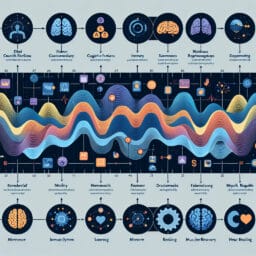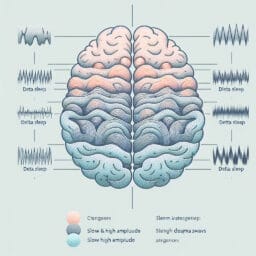
Understanding the Complexity: A Comprehensive Guide to Define Sleep Spindle
Table of Contents
- Introduction: Understanding Sleep Spindles
- The Science Behind Sleep Spindles
- The Importance of Sleep Spindles
- Detecting and Measuring Sleep Spindles
- Sleep Spindles in Sleep Disorders
- Conclusion: The Future of Sleep Spindle Research
- Frequently Asked Questions
Introduction: Understanding Sleep Spindles
Did you know that our brains are buzzing with activity even as we sleep? One of the key players in this nocturnal symphony is a phenomenon known as “sleep spindles.” These bursts of brain activity, detected through depth EEG, play a remarkable role in our sleep cycle and memory consolidation. During non-rapid eye movement (NREM) sleep, our brains produce these unique waveforms – fast spindles and slow spindles – each with varying frequencies and characteristics. Scientists have noted an intriguing connection between spindle density and sleep quality, suggesting the crucial part they play in a restful night’s sleep. The thalamic reticular nucleus generates these fascinating features – which modulate based on circadian rhythms – serving as markers for healthy human sleep patterns. However, fewer sleep spindles have been associated with cognitive decline and diseases like Alzheimer’s disease – emphasizing their importance beyond just being unusual brain waves during slumber. Thus, understanding these complex spindle activities could open doors to improving overall sleep health and combating debilitating neurological disorders. In the forthcoming sections, we delve deeper into what makes up a sleep spindle, how it can be accurately detected and measured along with their implications in various sleeping disturbances – all adding to the broader narrative of why unraveling mysteries of ‘sleep spindles’ is vital for modern neuroscience.
The Science Behind Sleep Spindles
In the quiet theater of sleep, a distinct yet silent performance unfolds. The silent actors – fast and slow spindles – star in this nocturnal drama, orchestrating an intricate ballet that intricately choreographs our night’s rest. This spindle activity is born from the depths of the thalamic reticular nucleus, filling our non-rapid eye movement (NREM) sleep stage with a flurry of brain activity. These unusual sleep spindles bear more than just the beauty of their waveform; they hold significant implications for our cognitive health. Remarkably different – slow spindles dominate early NREM stages with lower frequencies while fast spindles grace later stages – this duality serves us well, each playing an important role in memory consolidation.
A detailed study into spindle characteristics through depth EEG has revealed fascinating secrets about these nightly visitors. Notably, higher spindle density correlates directly to improved sleep quality and mental agility. In contrast, fewer sleep spindles have been detected in individuals suffering from cognitive decline or Alzheimer’s disease. This understanding hinges on precise spindle detection methodologies—paying attention to spindle frequency, amplitude, power and duration—to ensure accuracy.
What happens when circadian modulation influences these stars? An intriguing study found that the occurrence and power of sleep spindles differ across various stages of our biological clock’s cycle—indicating how deeply interconnected they are with our internal system’s rhythm.
The captivating phenomena known as ‘sleep spindles’ therefore play a crucial part in not only defining human sleep but also maintaining our long-term memory consolidation—a testament to their extraordinary influence over cognitive functions even as we slumber unaware.
| Term | Description |
|---|---|
| Sleep Spindles | Fascinating forms of brain activity that occur during non-rapid eye movement (NREM) sleep stage, originating from the thalamic reticular nucleus. They hold significant implications for our cognitive health. |
| Fast and Slow Spindles | Fast spindles occur in later stages of sleep, while slow spindles dominate early NREM stages. Despite their differences, both types play a crucial role in memory consolidation. |
| Spindle Density | A higher spindle density correlates directly to improved sleep quality and mental agility. People suffering from cognitive decline or Alzheimer’s disease have been found to have fewer sleep spindles. |
| Spindle Detection Methodologies | Understanding of sleep spindles depends on precise detection methods, which take into account spindle frequency, amplitude, power, and duration. |
| Circadian Modulation | The occurrence and power of sleep spindles vary across different stages of our biological clock’s cycle, showing their deep connection with our body’s internal rhythm. |
| Role in Cognitive Functions | Sleep spindles play a crucial part in defining human sleep and maintaining long-term memory consolidation, influencing our cognitive functions even during sleep. |
The Importance of Sleep Spindles
On the grand stage of human sleep, sleep spindles are the unsung maestros silently orchestrating a symphony that impacts not just our restfulness but also our cognitive health. Experts have discovered links between these unique brain waves and memory consolidation. Beyond their nocturnal appearance during non-rapid eye movement (NREM) sleep, it is during REM sleep that they work tirelessly to consolidate newly acquired information into long-term memories – a process akin to night-time filing of daytime learning. The spindle activity from both fast and slow spindles has been noted to be instrumental in this intricate process.
Furthermore, consistent studies on spindle density have confirmed an intriguing correlation – higher spindle density equates to improved sleep quality and better cognitive agility. Conversely, fewer detected spindles could potentially herald the onset of cognitive decline or Alzheimer’s disease.
However, the role of these unusual sleep spindles doesn’t end here; they also play an important part in maintaining a healthy sleep cycle. Originating from the thalamic reticular nucleus, fast and slow spindles occur at different NREM stages harmonizing with circadian modulation for optimal wake-rest balance. Undeniably then – whether it’s boosting memory consolidation or modulating our sleep cycle number – understanding these fascinating features known as “sleep spindles” holds paramount importance in enhancing overall brain health.
Detecting and Measuring Sleep Spindles
In the kaleidoscopic world of neuroscience, an intriguing performance unfolds each night in our brains – a symphony led by sleep spindles. These unique brain waves are detectable using depth EEG, offering insight into our nocturnal sleep cycle and cognitive health. The precision in spindle detection is vital; paying close attention to variables such as spindle frequency, amplitude, duration and power leads to an accurate understanding of this phenomenon. Interestingly enough, modulatory factors like circadian modulation can influence the activity of these spindles. A study found that the occurrence and power of sleep spindles vary with different stages of our biological clock’s cycle. Therefore, recognizing these patterns provides crucial information regarding our internal rhythm.
The importance of comprehending sleep spindle characteristics extends beyond academic curiosity – it holds significant implications for overall sleep quality and human cognitive function. A higher density of detected spindles during non-rapid eye movement (NREM) sleep correlates with improved cognitive agility and better-quality rest. In contrast, fewer sleep spindles could signal potential cognitive decline or herald diseases like Alzheimer’s disease.
Thus, every swirl in the sea of fast and slow spindles serves as a beacon guiding us through understanding human sleep patterns better—emphasizing why tracking these unusual sleep features is indispensable in modern neuroscience.
| Aspect | Description |
|---|---|
| Sleep Spindles | Unique brain waves detectable using depth EEG, providing insight into our nocturnal sleep cycle and cognitive health. |
| Importance of Spindle Detection | Precision in detection is crucial. Variables such as spindle frequency, amplitude, duration and power lead to an accurate understanding. |
| Modulatory Factors | Factors like circadian modulation influence the activity of sleep spindles. The occurrence and power of sleep spindles vary with different stages of our biological clock’s cycle. |
| Implications of Sleep Spindles | Understanding sleep spindle characteristics has significant implications for overall sleep quality and human cognitive function. A higher density of detected spindles during non-rapid eye movement (NREM) sleep correlates with improved cognitive agility and better-quality rest. |
| Indicators of Cognitive Decline | Fewer sleep spindles could signal potential cognitive decline or diseases like Alzheimer’s disease. |
| Role in Neuroscience | Tracking these unusual sleep features is indispensable in modern neuroscience. It helps in understanding human sleep patterns better. |
| Image |
Sleep Spindles in Sleep Disorders
Diving deeper into the realm of sleep medicine, a fascinating correlation surfaces between sleep spindles and common sleep disorders such as insomnia and sleep apnea. In these conditions marked by disrupted rest, the usual ebb and flow of spindle activity during NREM sleep stages appears to be out of sync. The harmonious dance between fast spindles and slow spindles, essential for our night’s orchestration, seems to lose its rhythm. This disarray further impacts memory consolidation – hinting at why chronic insomnia sufferers often report cognitive difficulties. Similarly intriguing is the relationship between narcolepsy – a neurological disorder characterized by excessive daytime sleepiness – and spindle density during REM sleep. Studies have noticed an aberrant pattern of fewer sleep spindles in people suffering from this condition, suggesting a potential biomarker for disease detection.
The impact of these disorders on brain activity isn’t just confined to nocturnal disruptions; it also alters our internal body clock’s circadian modulation—further proof that the unusual dynamics of brain waves significantly influence overall health beyond just dictating our stage-by-stage slumber dance. Delving into this intricate mechanism reveals not only how crucial recognizing each spindle feature is but also underscores their important role in guiding methodologies that could vastly improve management strategies for debilitating disorders like insomnia or narcolepsy.
Conclusion: The Future of Sleep Spindle Research
As we navigate the intricate pathways of human sleep, weave through NREM and REM stages, one can’t help but marvel at the significance of sleep spindles. These unique features of brain activity, with their fast and slow variations generated by the thalamic reticular nucleus, are not merely unusual brain waves. Instead, they play an important role in memory consolidation during sleep. Research has linked higher spindle density to improved sleep quality and cognitive functions while fewer detected spindles have been associated with cognitive decline or Alzheimer’s disease. The precise detection of these brain activities is crucial; spindle frequency, amplitude, power and duration all need accurate measurement for an insightful study. Furthermore intriguing is how circadian modulation influences their occurrence suggesting a deep connection with our internal body clock’s cycle. It’s clear that understanding these spindle features significantly contributes to a comprehensive view of human sleep patterns – a testament to why continued research into this fascinating field holds such promise for future advancements in neuroscience.


